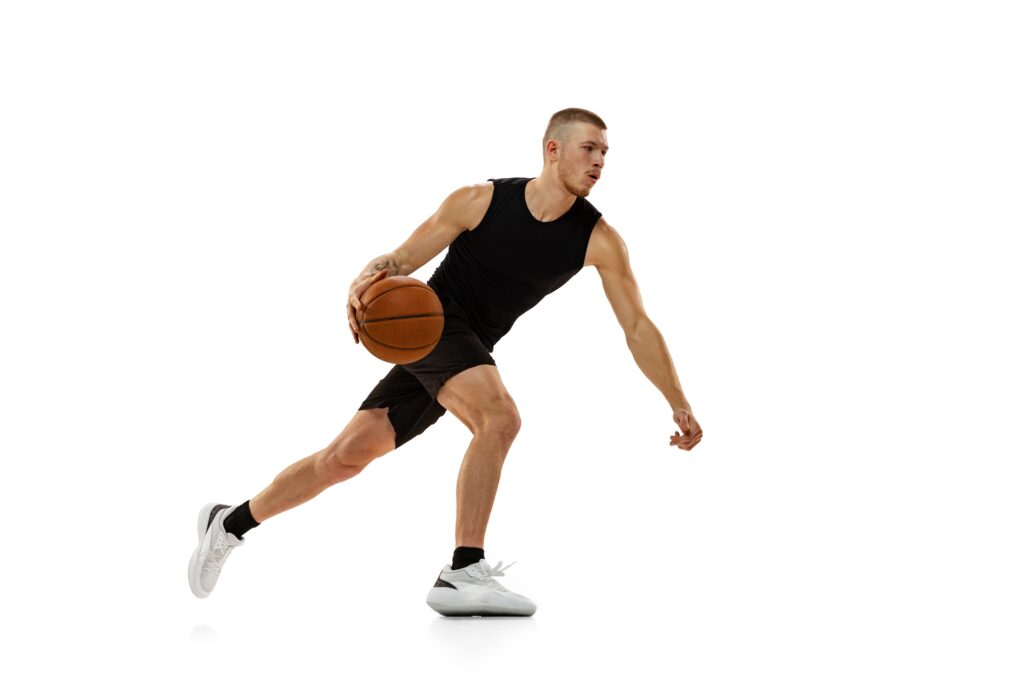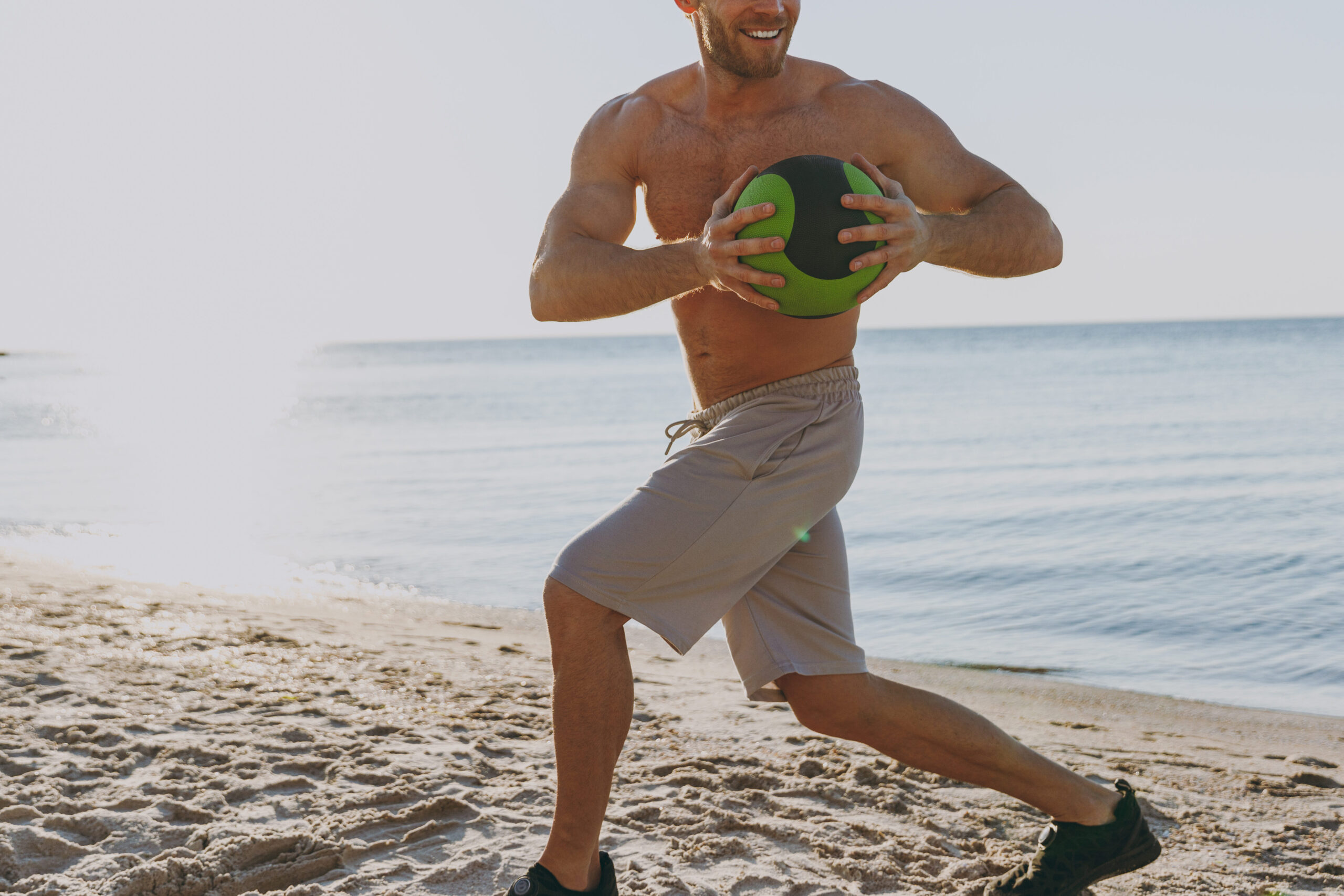So, you’ve decided to embark on a bulking journey, but you’re asking yourself, “should I do cardio while bulking?”
On one hand, you’ve heard that cardio can help you stay lean and healthy, but on the other hand, you’re worried that too much cardio might hinder your muscle growth. So how can you get the benefits of cardio without losing your hard-earned muscle?
The good news is it’s possible to do cardio and still maintain your gains.
In fact, many of my clients who train to bulk up are also involved in many cardio activities, including organized sports like basketball. Fortunately, their muscle building results are still high even with all of the cardio that they do.
I’m able to do the same as a formerly skinny guy obsessed with bulking up (see photo just below).
In this blog post, I’ll explore the role of cardio during bulking, how to find the perfect balance between cardio and muscle gains, and tips for choosing the right cardio exercises to maximize your results.
By the end of this blog post, you’ll have a better understanding of why cardio is essential during bulking and how to incorporate it effectively into your training plan.
Key Takeaways
Incorporate cardio into your bulking plan to maximize muscle growth and improve performance.
Find the right balance between cardio and muscle gains, limiting sessions to 2-3 times a week with moderate intensity.
Create a balanced bulking plan by setting goals, adjusting caloric intake & tracking progress for optimal results.
The Role of Cardio in Bulking

Contrary to popular belief that cardio is the arch-nemesis of muscle growth, integrating it into your bulking phase can indeed be advantageous.
Why?
Well, for starters, cardio can improve your body composition, boost your performance and endurance, and maintain your cardiovascular health during the bulking phase.
So, what’s the catch?
The key lies in finding the right balance between cardio and muscle gains, ensuring that you reap the benefits without sabotaging your progress.
A primary incentive for people incorporating cardio into their bulking strategy is the maintenance of a leaner physique. Cardio helps burn extra calories, which aids in keeping body fat levels in check.
Moreover, cardio boosts insulin sensitivity, allowing you to better utilize the calorie surplus needed for muscle growth. In a nutshell, adding cardio to your bulking routine can help you build muscle while keeping unwanted fat at bay.
Beyond enhancing body composition, cardio serves to:
Increase gym performance and endurance
Increase blood flow and oxygen delivery to your muscles, helping you perform better and recover faster between workouts
Maintain cardiovascular health, ensuring that your heart stays in tip-top condition throughout your bulking journey
So, actually, incorporating cardio into your bulking phase can translate to some nice improvements in the gym.
Cardio for Body Composition
In terms of body composition during bulking, low-intensity cardio activities can prove to be highly beneficial.
By burning extra calories, these exercises help you maintain a healthy body composition while still allowing for muscle gains.
For example, moderate-intensity exercises like jogging, cycling, or swimming can provide cardiovascular benefits without compromising muscle growth.
In addition to the fact that cardio burns calories, it can also improve insulin sensitivity, which plays a role in how effectively your body utilizes the calorie surplus needed for muscle growth. This means that, by incorporating cardio into your bulking routine, you can maintain a leaner physique while still maximizing your muscle gains. Not bad!
Boosting Performance and Endurance
The performance advantages of cardio during bulking should not be overlooked.
Incorporating cardio exercises, such as cycling or plyometrics, into your training routine can help build up your aerobic endurance and leg strength without putting too much stress on your joints. These exercises target smaller muscles that can be difficult to work with other exercises, giving you a boost in athletic performance.
Another advantage of adding cardio to your bulking routine is that it can help you recover faster between workouts. Cardio exercises improve blood flow and nutrient delivery to your muscles, allowing them to repair and grow more efficiently. So, while cardio might seem like the enemy of muscle growth, it can actually give you the edge you need to perform better and recover faster during your bulking phase.
Maintaining Cardiovascular Health
Heart health carries equal importance to muscle gains throughout the bulking phase.
Regular cardio exercises contribute to better cardiovascular health, faster recovery, and increased blood flow to your muscles. Depending on your current fitness level, you might need to adjust the amount and intensity of your cardio workouts to maintain a healthy heart during bulking.
A good rule of thumb is to incorporate light cardio a few days a week, for about 20-30 minutes per session. This not only helps keep your heart healthy but also reduces stress and improves nutrient delivery to your muscles.
So, don’t neglect your cardiovascular health in pursuit of muscle gains. A healthy heart is crucial for overall fitness and well-being.
Balancing Cardio and Muscle Gains

Having highlighted the significance of cardio during bulking, it’s time to discuss achieving an optimal balance between cardio and muscle gains.
As mentioned earlier, too much cardio can hinder muscle growth, so it’s essential to strike a balance to avoid slowing down your progress. This balance ensures that you reap the benefits of cardio without sacrificing muscle gains.
An essential factor in finding this balance is determining the right amount of cardio for your individual goals, energy levels, and recovery capacity. This will vary from person to person, but understanding how much cardio your body needs will help you optimize your bulking plan without negatively impacting your progress.
Finding the Right Amount of Cardio
So, what’s the method to determine the suitable amount of cardio for your bulking objectives?
Well, it depends on a few factors, such as your fitness goals, energy levels, and how well you can recover.
Start by considering your current fitness level and how much cardio you’ve been doing. If you’re new to exercise, you might need to start with a lower intensity and gradually build up as your fitness improves.
One approach is to limit your cardio sessions to 2-3 times a week, preferably on days when you’re not weight training. My clients all do their cardio on off-days, i.e. on days that they don’t do any weight training.
Keep your cardio sessions moderate, around 20-30 minutes, and focus on low-intensity exercises to minimize interference with muscle growth.
Prioritizing Recovery
It’s important to ensure proper recovery so you can balance cardio and muscle gains.
Ensuring adequate recovery time between cardio and weight training sessions is critical for optimal muscle growth. Remember, your muscles need time to grow and repair, so giving them the necessary rest and recovery is essential for progress.
As a general rule, aim for at least 24 to 48 hours of rest between cardio and weight training workouts. This allows your muscles to recover and grow, helping you achieve the best results from your bulking plan. Adequate rest, nutrition, and sleep are all essential components of a successful bulking journey, so don’t skimp on these crucial recovery aspects.
Choosing the Right Cardio for Your Bulking Goals

Given our discussion on the significance of cardio during bulking, you might be curious about the most suitable cardio exercises for your objectives.
The right cardio exercises can help you maximize muscle gains without negatively impacting your progress. In this section, we’ll discuss some cardio options that can complement your bulking plan and help you achieve your fitness goals.
The key is to select cardio exercises that align with your personal goals and preferences. Some options to consider include:
Low-impact, moderate-intensity activities
High-intensity interval training (HIIT)
Cycling
Swimming
Rowing
Jumping rope
Low-Impact, Moderate-Intensity Activities
If you’re looking for cardio exercises that won’t interfere with your muscle gains, consider low-impact, moderate-intensity activities like incline walking, cycling, or rowing. These exercises provide cardiovascular benefits while minimizing the risk of injury and muscle loss.
Low-impact, moderate-intensity activities that are ideal for maintaining cardiovascular fitness while minimizing interference with muscle gains include:
Walking
Cycling
Swimming
Elliptical training
Rowing
By incorporating these exercises into your bulking plan, you can enjoy the benefits of cardio while still focusing on building muscle mass.
High-Intensity Interval Training (HIIT)
High-Intensity Interval Training (HIIT) is another cardio option that can be beneficial for building explosive energy and muscle.
HIIT, also known as high intensity cardio, involves:
Alternating intense exercise with recovery periods
Can be used with various types of cardio, combining both aerobic and strength training
Known for being efficient and can help improve cardiovascular and metabolic health
However, try to use HIIT sparingly during bulking to avoid excessive calorie expenditure, which can interfere with muscle recovery and growth.
Creating a Balanced Bulking Plan

Having discussed the significance of cardio in bulking and methods to strike the right balance, the next step is to formulate a personalized bulking plan.
A balanced bulking plan involves setting personal goals, adjusting caloric intake, and monitoring progress to make necessary adaptations. With the right plan in place, you can maximize your muscle gains while still enjoying the benefits of cardiovascular exercise.
To develop a successful bulking plan, follow these steps:
Establish clear goals for your desired muscle mass, strength gains, and body fat percentage.
Adjust your caloric intake to ensure a surplus for muscle growth while accounting for the calories burned during cardio sessions.
Regularly track your progress and make adjustments as needed to optimize your results.
Establishing Personal Goals
What exactly are you trying to achieve? Bigger muscles? Getting stronger? Lowering your body fat percentage?
Establishing distinct objectives for your bulking journey is key to success.
Consider factors such as desired muscle mass, strength gains, and body fat percentage when defining your objectives. By having a clear vision of what you want to achieve, you can tailor your training and nutrition plan to support your goals and maximize results.
Keep in mind that everyone’s goals and progress will differ. What works for someone else might not work for you, so it’s essential to stay focused on your personal objectives and adjust your plan as needed. Stay patient, committed, and consistent.
Adjusting Caloric Intake
Probably the most important factor in balancing cardio and muscle gains lies in correctly monitoring your caloric intake.
That means adjusting your calorie calculations according to your cardio activities.
As previously highlighted, calorie intake adjustment plays a crucial role in a successful bulking strategy. To promote muscle growth, you’ll need to consume more calories than you burn during your workouts. This surplus ensures that your body has the necessary energy and nutrients to build muscle.
When adjusting your caloric intake, consider the burn calories effect during your cardio sessions. If you’re engaging in regular cardio exercises, you may need to consume additional calories to compensate for the energy expended during those workouts. Focus on nutrient-dense foods, such as lean proteins, whole grains, and healthy fats, to fuel your muscle growth and support your bulking goals.
Monitoring Progress and Adapting
Frequent tracking of your progress is super important when you’re trying to bulk.
By tracking your gains, you can make necessary adjustments to your training and nutrition if needed. This helps you ensure that you’re gaining muscle at the right pace and minimizing fat gain, while taking in enough calories to support your goals.
Methods for tracking progress include weighing yourself, taking progress photos, and measuring body composition. By keeping a close eye on your progress, you can fine-tune your bulking plan and make the necessary adjustments to achieve the best results possible, especially if your goal is to gain weight.
Summary
In conclusion, cardio activities can and should be incorporated when bulking. They’re crucial in improving body composition, enhancing performance and endurance, and maintaining cardiovascular health.
Striking the right balance between cardio and muscle gains is key to maximizing your results while still reaping the benefits of cardiovascular exercise. By setting clear goals, adjusting your caloric intake, and monitoring your progress, you can create a balanced bulking plan that supports your fitness goals.
So, don’t hesitate when incorporating cardio into your bulking plan.
With the right balance and approach, you can enjoy the benefits of cardio without sacrificing muscle growth.
Frequently Asked Questions
Should you do cardio if you are bulking?
For some lifters, adding low-intensity cardio while bulking can be beneficial in maintaining base fitness levels and ensuring cardiovascular health isn’t ignored. For hard gainers however, it could be counterproductive to their bulking efforts so it should be approached carefully. A careful approach is possible by correctly tracking daily caloric expenditure and intake.
Is it OK to run while bulking?
It is possible to run while bulking, however it’s important to opt for low intensity exercises that won’t burn too many calories and disrupt your bulk. Be sure to pay close attention to resistance training, runs, and nutrition in order to get the desired results.
How much cardio should I do while bulking?
For a successful bulking phase, it is best to stick to 2-3 cardio sessions per week on non-weight training days.
How can I track my progress during the bulking phase?
Track your progress during the bulking phase by weighing yourself, taking progress photos, and measuring body fat percentange regularly. Monitoring your progress helps you adjust your training and nutrition plan as necessary.
How do I adjust my caloric intake for bulking?
If you’re looking to bulk up, eat more than you burn during workouts and compensate for any extra energy expended during cardio activities like organized sports. This will help promote muscle growth.


Recent Comments